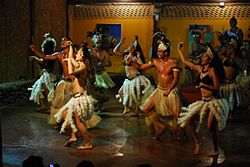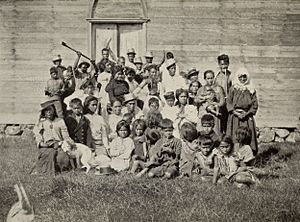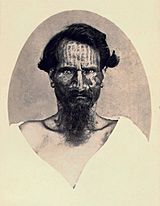Rapa Nui people facts for kids

Traditional dance of Rapa Nui people
|
|
| Total population | |
|---|---|
| ca. 5,682 | |
| Regions with significant populations | |
| Chile (particularly Easter Island) | |
| Languages | |
| Rapa Nui language, Chilean Spanish | |
| Religion | |
| Roman Catholicism | |
| Related ethnic groups | |
| Oparoan, Tahitian |
The Rapa Nui are the original Polynesian people who live on Easter Island in the Pacific Ocean. Easter Island is also known as Rapa Nui. They are the easternmost Polynesian culture. About 60% of the people living on Easter Island today are descendants of the first Rapa Nui settlers. Many Rapa Nui people also live in mainland Chile.
They speak both their traditional Rapa Nui language and Spanish, which is Chile's main language. In 2002, there were 3,304 people living on the island. Most of them lived in the village of Hanga Roa on the west coast. Since 2011, the Rapa Nui people's main way to earn money has been from tourism. Tourists often come to see the giant stone statues called moai.
Rapa Nui activists are working to gain more control over their island. In 2010 and 2011, protests by the Rapa Nui against a new marine park led to clashes with Chilean police.
Contents
History of the Rapa Nui People
When Did the Rapa Nui Arrive?
Experts believe the Rapa Nui people first settled Easter Island between 300 and 1200 CE. Older ideas suggested they arrived around 700–800 CE. However, newer tests using radiocarbon dating point to a later arrival, possibly as late as 1200 CE.
Scientists have studied the DNA of ancient skeletons. These studies show that the Rapa Nui people came from Polynesia. Other DNA tests in 2007 found signs of European and Native American DNA. This suggests that people from Europe and the Americas mixed with the Rapa Nui before or during the early 1800s.
First European Visitors to Easter Island
Jacob Roggeveen was the first European to write about meeting the Rapa Nui people. He arrived at Easter Island on April 5, 1722, which was Easter Sunday. He stayed on the island for about a week.
Felipe González de Ahedo visited the Rapa Nui in 1770. He claimed the island for Spain. The islanders wrote on his official document using rongorongo. This is a special Rapa Nui writing system that we still cannot understand today. Later, James Cook visited in 1774 and Jean-François de Galaup, comte de Lapérouse, visited in 1786. Both stayed for only a few days.
Rapa Nui Culture and Traditions
Language of the Rapa Nui
The Rapa Nui people today speak Spanish and their traditional Rapa Nui language. The Rapa Nui language is also called Pascuan. It is an Eastern Polynesian language and is written using the Latin alphabet. Most Rapa Nui people speak Spanish as their main language. Spanish is the most common language on Easter Island. It is also the main language used in schools and government.
Some people believe the Rapa Nui language is starting to use more Spanish sentence structures. Rongorongo is a system of symbols found in the 1800s. It might be an older form of the Rapa Nui language. However, scientists are still trying to figure out if Rongorongo is a true writing system or another type of cultural expression.
Rapa Nui Mythology and Beliefs
Two important stories in Rapa Nui mythology are about Hotu Matu'a and the Tangata manu. Hotu Matu'a is believed to be the first person to settle Easter Island.
The Tangata manu is part of the Birdman religion. In this religion, the creator god was Makemake. People would compete to find an egg. The winner would become the sacred "birdman" for five months. A dwarf planet called Makemake is named after this god. More recent Rapa Nui stories include a big battle between the Hanau epe and the Hanau Momoko.
The Famous Moai Statues
The most famous part of Rapa Nui culture is the moai. These are 887 huge human figures carved from rock. They were made between 1250 and 1500 CE. Then, they were moved all over Easter Island. People believed the moai were the living faces of their ancestors. By 1868, all of them had fallen over.
The moai stand on large stone platforms called ahu. The biggest ahu is Ahu Tongariki. Another famous one is Ahu Vinapu. Some moai wear hats made of red volcanic stone called Pukao. Today, the Rapa Nui people and the Chilean government are working to protect and fix these statues. A large area with many statues, Rapa Nui National Park, is a World Heritage site.
Rapa Nui Art and Creativity
Historically, the Rapa Nui people made feather headdresses, bark cloth, and carvings from wood and stone. They used blunt, round stones called adzes to carve stone images and wood. A special feature of Rapa Nui statues is their eyes. They were made from shell or coral with black obsidian in the middle.
Music of Easter Island
Traditional Rapa Nui music includes singing and chanting. They use instruments like conch shell trumpets and accordions. They also use percussive dancers and the kauaha, which is a percussion instrument made from a horse's jaw bone. Modern Rapa Nui music has been influenced by Latin American styles. This has created new types of music, like the Rapa Nui style of tango. Matato'a is a famous music group from the island. They help keep traditional dances and music alive.
Rapa Nui Tattoos
Like other Polynesian islands, tattoos and body paintings were very important spiritually. Sometimes, tattoos were thought to bring divine strength or mana. They showed off the Rapa Nui culture. Priests, warriors, and chiefs had more tattoos than others. This showed their higher social rank. Both men and women got tattoos to show their social class.
Tattoos were made using bone needles and combs called Uhi. These tools were made from bird or fish bones. The ink came from natural things. It was mainly made by burning Ti leaves (Cordyline terminalis) and sugar cane.
Tattoos were named based on where they were on the body:
- Rima kona: On the back of the hand or wrist.
- Retu: On the forehead.
- Matapea: Under the eyes.
- Pangaha’a: On the cheeks.
- Pare: On the arms.
- Humu: On the thighs and/or calves.
- Tu’u haino ino: On the back and buttocks.
Rapa Nui tattoos, like other art forms, mix human and animal shapes. Common symbols included the Make-Make god, Moais, Komari (a symbol for female fertility), the manutara bird, other birds, fish, turtles, or figures from the Rongorongo tablets. Some designs were very common. Women and men often had thick lines on their faces. These lines went across the forehead from one ear to the other. They were curved and had large dots (humu or puraki, meaning "to enclose") on the forehead and temples.
Sebastian Englert said that tattooing, also called Tatú or Tá kona, was a natural way for islanders to express themselves. He often saw both adults and children with these paintings. "Ta" means to write or engrave, and "kona" means place. So, the whole word means "the place to engrave."
Today, young people are bringing back Rapa Nui tattoos. They see them as a key part of their culture. Local artists create new designs based on traditional patterns.
Rapa Nui and Their Environment
Why Did the Island Change?
Many people believe that the Rapa Nui culture declined before Europeans arrived in 1722. This decline might have been caused by using too many of the island's natural resources. A big problem was the cutting down of almost all the island's trees. Jared Diamond wrote about this idea in his 2005 book Collapse. He suggested that the Rapa Nui caused an "ecocide" on Easter Island.
This idea of collapse comes from the thought that there weren't enough resources on the island. Things like population, wood, and food sources might have been out of balance. Building and moving the huge moai statues needed a lot of energy and resources. Food might have been harder to find than on other Polynesian islands. This was because of the cooler climate, less rain, strong winds, and not many different kinds of plants and animals. Common Polynesian crops did not grow as well here. Also, there is very little good timber on the island now. The tallest plants are only about 7 feet tall.
Easter Island currently has only 48 different kinds of plants. But studies of ancient pollen show it once had many more. From these samples, 22 types of plants that are no longer on the island once grew there. This included a giant palm tree, the Rapa Nui Palm. It was likely the biggest palm species in the world, even bigger than the Chilean Wine Palm, but it is now extinct.
Easter Island also used to have more diverse animals. The bones of 25 different types of nesting birds have been found. Now, only 16 types remain. This loss of species often happens when humans settle a new area. They tend to hunt too much and use too many resources.
Cutting down trees would have led to less food from crops. This is because soil would wash away. People would also lose wood needed to build fishing boats and other things. It would have also stopped the building of the moai. Diamond suggests that not having enough resources might have led to a civil war. This could have caused the population to drop. He thinks there were about 7,000 people before the war. This number fell to 2,000 when missionaries arrived in the 1800s and counted the island's people for the first time.
Other ideas for the decline include too many people on the island. Or, it could have been the arrival of Europeans and the diseases they brought, like smallpox.
Farming on Easter Island
Farming on Easter Island became more advanced before Europeans arrived. This was needed because of the island's windy climate and low rainfall. Archaeologists have found many composting pits and irrigation systems. Large rocks were also stacked to block the wind.
Farmers used a method called lithic mulch in their fields. In this method, farmers would lay rocks in patterns. This made plants grow in certain areas. This method helps keep the soil moist. It also reduces soil erosion from the wind. This helped farmers deal with the tough climate.
Crops grown on Easter Island included sweet potatoes, yams, taro, bananas, and sugarcane. Chickens were the only domestic animals. The "chicken coops" carved from stone that are still on the island were probably tombs. Chickens might have gotten calcium and phosphorus from the bones inside these tombs.
Images for kids
See also
 In Spanish: Rapanui (etnia) para niños
In Spanish: Rapanui (etnia) para niños






